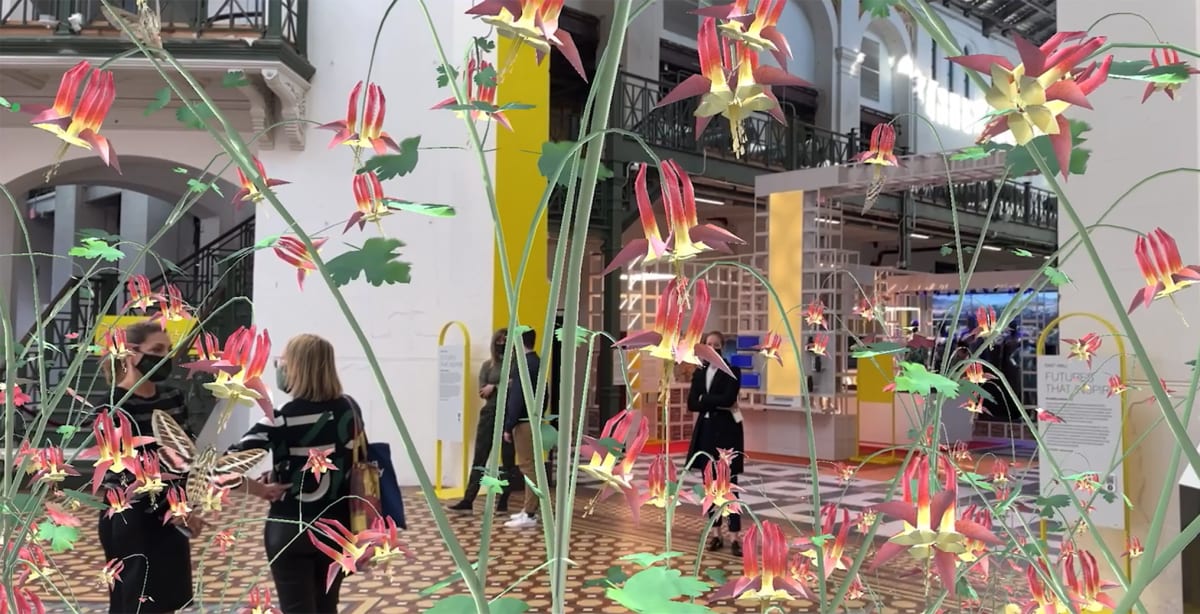Tamiko Thiel
GAZELL.iO welcomes Tamiko Thiel as artist in residence for January, 2022.
WORDS BY TAMIKO THIEL
I want to take this opportunity as Gazelli Digital Artist in Residence to talk about a visual device that I love to use in my artworks but have rarely discussed: particle systems.
I am not so fond of the hard geometric line or hard solid aesthetics. In the early 2000s, while I was creating vast virtual worlds, I discovered particle systems (and the more goal-directed flocking systems). I loved the amorphous, organic, atmospheric aspect they can bring to time-based and spatial artworks. Their use involves giving up a certain amount of control and openness to the “happy accident” that collaborations with others – whether machine or human! – can bring to your work.
My art practice grew out of my earlier work as a product design engineer and sharing control with technology has always been a natural part of my artmaking. However, during my mechanical engineering graduate studies at MIT in the early 1980s, 3D computer graphics were limited to simple rotating geometric forms or, at best, - animated logos made of letters. Although I resolved to become a media artist at this time, I felt 3D computer graphics itself needed more time to develop before it would interest me aesthetically.
My final work as a mechanical engineering product designer (that I also consider my first professional artwork) was the first work I did that used the expressive capabilities of a “cloud” of lights. Danny Hillis, a friend from the MIT Artificial Intelligence Lab, asked me to do the product design for his revolutionary, massively parallel artificial intelligence supercomputer, the Connection Machine CM-1/CM-2. Besides the practical, physical construction of the machine, I spent two years submerging myself in the history, technology, and sci-fi fantasies of artificial intelligence to come up with a form that would adequately express our dream of creating intelligent machines.
My roots in modernist aesthetics demanded that Form Follows Function. (Only later did I find out that for Louis Sullivan, the architect who formulated this famous phrase, the emotional function expressed by the decoration on his buildings was as vital to him as his works’ physical and structural functions.) Trying to find a form to communicate the “function” of the Connection Machine supercomputer, a symbolic processing machine, I concluded that the proper function could also only be expressed symbolically. The actual computing functionality was invisible, hidden in the silicon layers of the processor chips and the miles of traces and wires that connected them.
In the final design, my team and I let the external form speak for the internal hardware structure: we created a matt black cube-of-cubes that expressed the internal 12-dimensional hypercube network connecting the 64,000+ processors. In the software aspect, the data exchanged between the processors and the data structures whose topology was independent of the hardware topology, we symbolised as a cloud of blinking lights, in the physical form of the red LED status lights connected to each of the processor chips. We made the machine’s doors translucent, so the machine seemed alive, “speaking for itself” and communicating with us humans via the blinking status lights from within the device.
During my residency, I will discuss how I use the visual and spatial characteristics of “clouds” of visual or audio sources to add emotional and communicative expression to my artworks.
*In 1989, the Connection Machine CM-2 was the fastest supercomputer globally. Google and Nvidia developed their hardware and software concepts further to become the tech giants they are now. The machine also inspired Steve Jobs to change his product aesthetics from earlier, more “cuddly” forms such as the Macintosh into the sublime aesthetic of the NeXT Cube and all his subsequent products. This influence was recognised by the Museum of Modern Art in New York 30 years later when I helped it add a CM-2 to its permanent collection.







